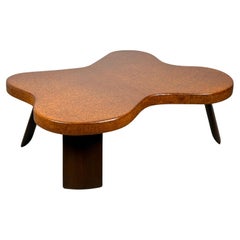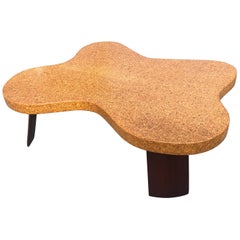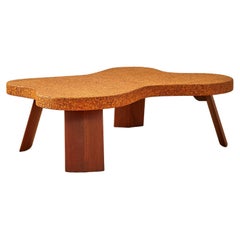Paul Frankl 5005
Mid-20th Century American Mid-Century Modern Coffee and Cocktail Tables
Mahogany, Cork
Recent Sales
Mid-20th Century American Mid-Century Modern Coffee and Cocktail Tables
Cork
20th Century American Mid-Century Modern Coffee and Cocktail Tables
Mahogany, Cork
Mid-20th Century American Mid-Century Modern Coffee and Cocktail Tables
Cork
Vintage 1950s American Mid-Century Modern Coffee and Cocktail Tables
Mahogany, Cork
Mid-20th Century American Mid-Century Modern Coffee and Cocktail Tables
Mahogany, Cork
Vintage 1950s American Mid-Century Modern Coffee and Cocktail Tables
Mahogany, Cork
Mid-20th Century American Mid-Century Modern Coffee and Cocktail Tables
Cork, Mahogany
Mid-20th Century American Mid-Century Modern Coffee and Cocktail Tables
Cork
Mid-20th Century American Mid-Century Modern Coffee and Cocktail Tables
Cork
Vintage 1950s American Mid-Century Modern Coffee and Cocktail Tables
Mahogany, Cork
Mid-20th Century American Post-Modern Coffee and Cocktail Tables
Cork
People Also Browsed
21st Century and Contemporary American Organic Modern Stools
Steel
Vintage 1970s German Mid-Century Modern Flush Mount
Metal
Vintage 1950s Austrian Mid-Century Modern Chandeliers and Pendants
Metal
21st Century and Contemporary Italian Mid-Century Modern Wall Lights and...
Gold Plate
Late 20th Century Italian Art Deco Wall Lights and Sconces
Murano Glass
Mid-20th Century European Mid-Century Modern Coat Racks and Stands
Brass
21st Century and Contemporary Finnish Mid-Century Modern Screens and Roo...
Wood, Pine
Vintage 1940s Swedish Scandinavian Modern Coffee and Cocktail Tables
Mahogany
Vintage 1980s French Mid-Century Modern Shelves
Elm
21st Century and Contemporary Dutch Brutalist Dining Room Tables
Oak, Walnut
Mid-20th Century Italian Mid-Century Modern Wall Lights and Sconces
Brass
21st Century and Contemporary Spanish Mid-Century Modern Chandeliers and...
Metal
2010s Portuguese Modern Table Lamps
Ceramic, Clay
2010s Italian Modern Coffee and Cocktail Tables
Glass, Murano Glass
Vintage 1950s Italian Mid-Century Modern Wall Lights and Sconces
Murano Glass
21st Century and Contemporary American Minimalist Night Stands
Oak
Paul Frankl for sale on 1stDibs
Born in Vienna, Paul Frankl came to the United States in 1914 as part of a wave of Central European design luminaries — among them Kem Weber, Rudolph Schindler, and Richard Neutra — who were drawn by the energy and optimism of the American scene. Prolific and protean, Frankl would go on to design furnishings that are emblematic of nearly every key stylistic chord in American modernism, from the streamlined Art Deco to free-form organic shapes.
Frankl's Skyscraper cabinets, bookcases and more — introduced in 1924 — are his earliest and best-known designs (and the work by which he is most often represented in institutions, such as New York’s Metropolitan Museum of Art). Tall and narrow, the pieces have staggered shelves meant to mimic the setbacks of Manhattan office towers. A later visually expressive line — the Speed chairs and sofas, which have a raked profile suggesting motion — links Frankl to Donald Deskey, Raymond Loewy and other creators of Streamline Moderne design.
Frankl moved to Los Angeles in 1934 and luxuriated in the climate and lifestyle. His designs became lighter and simpler and found an audience among the Hollywood élite. (Katharine Hepburn, Cary Grant and Fred Astaire were clients.) Fascinated by Asian arts, Frankl produced numerous pieces — tabletops with edges that curve upward; sofas, chairs and other seating with rattan frames — inspired by Chinese and Japanese forms and materials. In the 1940s, Frankl became one of the first designers to incorporate free-form, biomorphic shapes in his work, as well as novel upholstery fabrics such as denim and nubby wool.
Frankl biographer Christopher Long argues that the designer’s easy, elegant aesthetic had an enormous influence on movie set design. As the furniture below attests, Paul Frankl’s work is ready for its close-up.
Find vintage Paul Frankl tables, dining chairs, case pieces and storage cabinets on 1stDibs.
A Close Look at Mid-century Modern Furniture
Organically shaped, clean-lined and elegantly simple are three terms that well describe vintage mid-century modern furniture. The style, which emerged primarily in the years following World War II, is characterized by pieces that were conceived and made in an energetic, optimistic spirit by creators who believed that good design was an essential part of good living.
ORIGINS OF MID-CENTURY MODERN FURNITURE DESIGN
- Emerged during the mid-20th century
- Informed by European modernism, Bauhaus, International style, Scandinavian modernism and Frank Lloyd Wright’s architecture
- A heyday of innovation in postwar America
- Experimentation with new ideas, new materials and new forms flourished in Scandinavia, Italy, the former Czechoslovakia and elsewhere in Europe
CHARACTERISTICS OF MID-CENTURY MODERN FURNITURE DESIGN
- Simplicity, organic forms, clean lines
- A blend of neutral and bold Pop art colors
- Use of natural and man-made materials — alluring woods such as teak, rosewood and oak; steel, fiberglass and molded plywood
- Light-filled spaces with colorful upholstery
- Glass walls and an emphasis on the outdoors
- Promotion of functionality
MID-CENTURY MODERN FURNITURE DESIGNERS TO KNOW
- Charles and Ray Eames
- Eero Saarinen
- Milo Baughman
- Florence Knoll
- Harry Bertoia
- Isamu Noguchi
- George Nelson
- Danish modernists Hans Wegner and Arne Jacobsen, whose emphasis on natural materials and craftsmanship influenced American designers and vice versa
ICONIC MID-CENTURY MODERN FURNITURE DESIGNS
- Eames lounge chair
- Nelson daybed
- Florence Knoll sofa
- Egg chair
- Womb chair
- Noguchi coffee table
- Barcelona chair
VINTAGE MID-CENTURY MODERN FURNITURE ON 1STDIBS
The mid-century modern era saw leagues of postwar American architects and designers animated by new ideas and new technology. The lean, functionalist International-style architecture of Le Corbusier and Bauhaus eminences Ludwig Mies van der Rohe and Walter Gropius had been promoted in the United States during the 1930s by Philip Johnson and others. New building techniques, such as “post-and-beam” construction, allowed the International-style schemes to be realized on a small scale in open-plan houses with long walls of glass.
Materials developed for wartime use became available for domestic goods and were incorporated into mid-century modern furniture designs. Charles and Ray Eames and Eero Saarinen, who had experimented extensively with molded plywood, eagerly embraced fiberglass for pieces such as the La Chaise and the Womb chair, respectively.
Architect, writer and designer George Nelson created with his team shades for the Bubble lamp using a new translucent polymer skin and, as design director at Herman Miller, recruited the Eameses, Alexander Girard and others for projects at the legendary Michigan furniture manufacturer.
Harry Bertoia and Isamu Noguchi devised chairs and tables built of wire mesh and wire struts. Materials were repurposed too: The Danish-born designer Jens Risom created a line of chairs using surplus parachute straps for webbed seats and backrests.
The Risom lounge chair was among the first pieces of furniture commissioned and produced by celebrated manufacturer Knoll, a chief influencer in the rise of modern design in the United States, thanks to the work of Florence Knoll, the pioneering architect and designer who made the firm a leader in its field. The seating that Knoll created for office spaces — as well as pieces designed by Florence initially for commercial clients — soon became desirable for the home.
As the demand for casual, uncluttered furnishings grew, more mid-century furniture designers caught the spirit.
Classically oriented creators such as Edward Wormley, house designer for Dunbar Inc., offered such pieces as the sinuous Listen to Me chaise; the British expatriate T.H. Robsjohn-Gibbings switched gears, creating items such as the tiered, biomorphic Mesa table. There were Young Turks such as Paul McCobb, who designed holistic groups of sleek, blond wood furniture, and Milo Baughman, who espoused a West Coast aesthetic in minimalist teak dining tables and lushly upholstered chairs and sofas with angular steel frames.
Generations turn over, and mid-century modern remains arguably the most popular style going. As the collection of vintage mid-century modern chairs, dressers, coffee tables and other furniture for the living room, dining room, bedroom and elsewhere on 1stDibs demonstrates, this period saw one of the most delightful and dramatic flowerings of creativity in design history.
Materials: Cork Furniture
Cork furniture is back — and for good reason: Renewable, recyclable, lightweight, inexpensive and warm, it seems to have no downside.
The versatile material has cycled in and out of fashion in furniture and interior design since its mid-century heyday, when visionary creators from Edward Wormley to Frank Lloyd Wright used it in some of their most famous work.
Today, the wheel has turned once more in cork’s favor, as designers trend toward more eco-friendly options. In addition to its aforementioned attributes and the fact that it is waterproof and highly insulating, the cork oak trees (native to Portugal and Spain) from whose bark it is made are unharmed by the harvesting.
Cork, in short, is more than just a convenient bottle stopper. As the environmental impact becomes an increasingly important consideration, furniture designers are turning to the material in droves.
Shop a wide variety of cork tables, cork seating and other cork furnishings on 1stDibs.
Finding the Right Coffee-tables-cocktail-tables for You
As a practical focal point in your living area, antique and vintage coffee tables and cocktail tables are an invaluable addition to any interior.
Low tables that were initially used as tea tables or coffee tables have been around since at least the mid- to late-1800s. Early coffee tables surfaced in Victorian-era England, likely influenced by the use of tea tables in Japanese tea gardens. In the United States, furniture makers worked to introduce low, long tables into their offerings as the popularity of coffee and “coffee breaks” took hold during the late 19th century and early 20th century.
It didn’t take long for coffee tables and cocktail tables to become a design staple and for consumers to recognize their role in entertaining no matter what beverages were being served. Originally, these tables were as simple as they are practical — as high as your sofa and made primarily of wood. In recent years, however, metal, glass and plastics have become popular in coffee tables and cocktail tables, and design hasn’t been restricted to the conventional low profile, either.
Visionary craftspeople such as Paul Evans introduced bold, geometric designs that challenge the traditional idea of what a coffee table can be. The elongated rectangles and wide boxy forms of Evans’s desirable Cityscape coffee table, for example, will meet your needs but undoubtedly prove imposing in your living space.
If you’re shopping for an older coffee table to bring into your home — be it an antique Georgian-style coffee table made of mahogany or walnut with decorative inlays or a classic square mid-century modern piece comprised of rosewood designed by the likes of Ettore Sottsass — there are a few things you should keep in mind.
Both the table itself and what you put on it should align with the overall design of the room, not just by what you think looks fashionable in isolation. According to interior designer Tamara Eaton, the material of your vintage coffee table is something you need to consider. “With a glass coffee table, you also have to think about the surface underneath, like the rug or floor,” she says. “With wood and stone tables, you think about what’s on top.”
Find the perfect centerpiece for any room, no matter what your personal furniture style on 1stDibs — shop Art Deco coffee tables, travertine coffee tables and other antique and vintage coffee tables and cocktail tables today.


